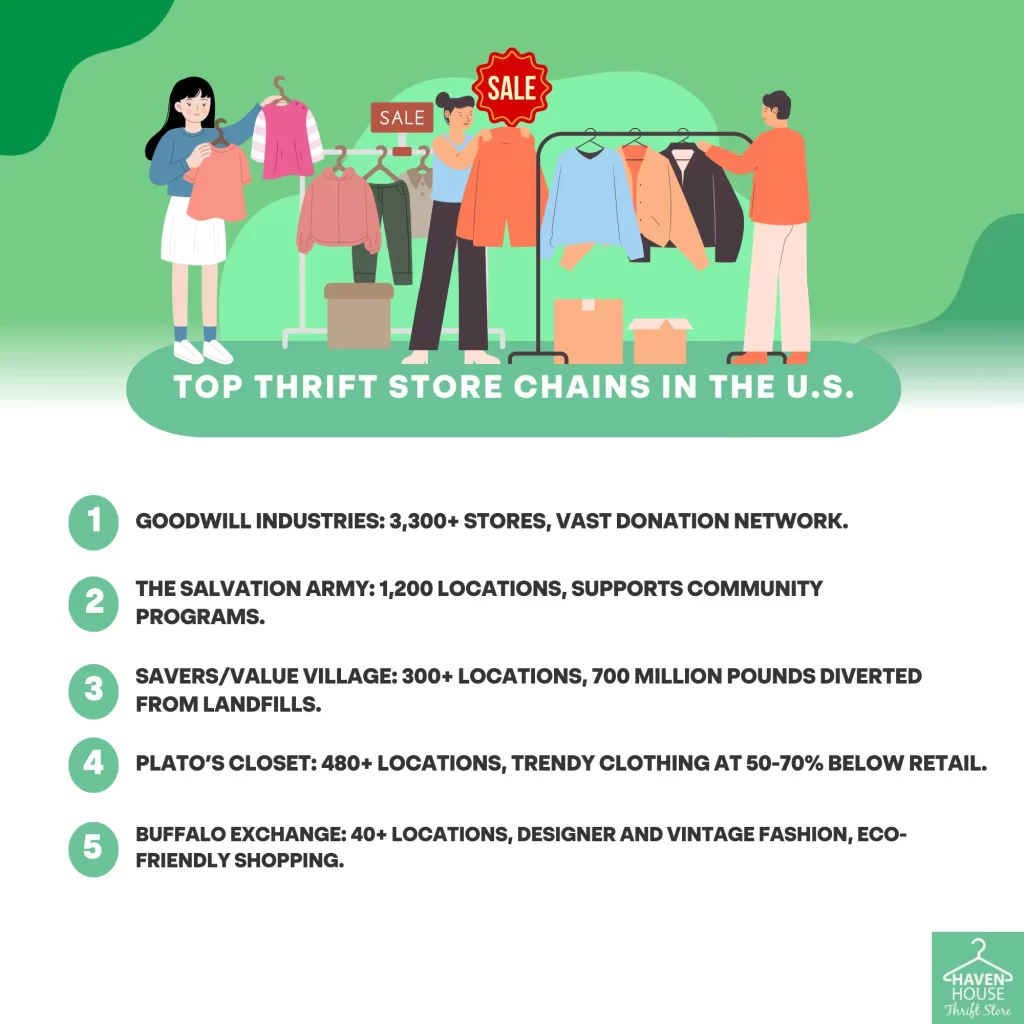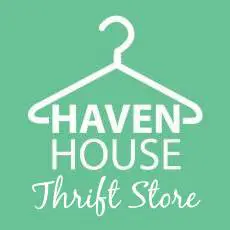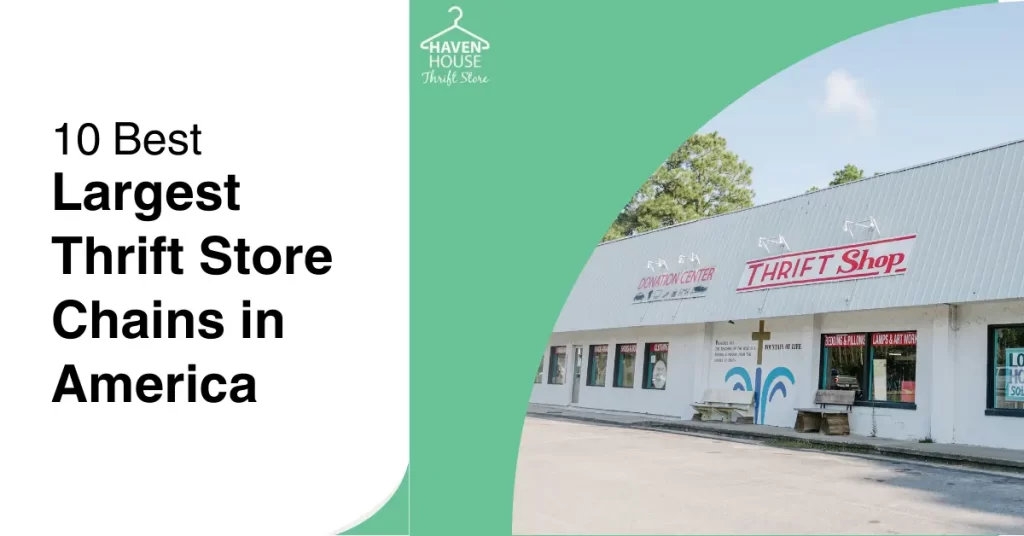If you’re looking to explore America’s largest thrift store chains, start with Goodwill Industries, boasting over 3,300 stores and a vast donation network. The Salvation Army‘s 1,200 locations support extensive community programs, while Savers and Value Village offer sustainable shopping with over 300 locations. St. Vincent De Paul and Deseret Industries provide diverse inventories and community aid. Trend seekers will find Buffalo Exchange, Crossroads Trading, Plato’s Closet, and Uptown Cheapskate catering to eco-conscious fashionistas. Together, these chains illustrate the growing trend towards sustainable and cost-effective shopping. Discover how these thrift giants shape the reuse economy in America.

Key Takeaways
- Goodwill Industries leads with over 3,300 stores, extensive donations, and strong e-commerce presence.
- The Salvation Army operates 1,200 stores, funding community programs with 82 cents of every dollar.
- Savers and Value Village run 300+ locations, diverting 700 million pounds from landfills annually.
- Plato’s Closet has over 480 locations, offering trendy clothing at 50-70% below retail prices.
- Buffalo Exchange, with 40+ locations, curates designer and vintage fashion, diverting over 1 million pounds of clothing from landfills.
Goodwill Industries
Goodwill Industries, with over 3,300 stores across the United States, remains a dominant player in the thrift store market by leveraging its extensive reach and robust donation network. As the largest thrift store chain in the country, Goodwill’s expansive footprint means you’re likely to find a store in almost every community. This extensive network is a significant factor behind their market dominance, allowing them to process a higher volume of donations and offer a wider variety of products.
Goodwill’s model relies heavily on local donations, contributing to its position as the biggest thrift store in America. By fostering strong community ties, they create a sustainable cycle of giving and repurposing. Data shows that Goodwill processes millions of pounds of donations annually, translating into a vast inventory that attracts a diverse customer base.
Market trends indicate that the demand for second-hand goods is growing, driven by increased consumer interest in sustainability and budget-friendly shopping. Goodwill has capitalized on this trend by investing in e-commerce platforms, broadening their reach even further. This adaptability guarantees Goodwill maintains its status as the premier thrift store chain in America, meeting changing consumer preferences effectively.
The Salvation Army
You’ll find The Salvation Army stands out with a wide product variety, catering to diverse consumer needs and preferences. Additionally, their robust community support programs greatly boost their brand loyalty and market presence. Analyzing recent trends, it’s clear that these factors contribute to their sustained growth and competitive edge in the thrift store industry.
Wide Product Variety
With over 1,200 stores nationwide, The Salvation Army offers a wide product variety that caters to diverse consumer needs and preferences. As one of the largest thrift store chains in the country, their extensive inventory ranges from clothing and accessories to furniture and household goods. This variety makes The Salvation Army a go-to destination for bargain hunters and those looking to furnish their homes on a budget. In fact, the biggest thrift store in America often features a rotating selection of unique items, keeping the shopping experience fresh and engaging.
Market trends indicate a growing consumer interest in sustainable shopping, and The Salvation Army is capitalizing on this by offering second-hand goods at competitive prices. Data shows that millennials and Gen Z are driving the resale market, and The Salvation Army’s wide product range appeals directly to these demographics. By continuously updating their inventory, they meet the demands of fashion-forward shoppers and eco-conscious consumers alike.
Furthermore, The Salvation Army’s strategic locations in urban and suburban areas guarantee accessibility, making it easier for consumers to find what they need. Their robust product variety not only boosts customer satisfaction but also solidifies their position as a leader in the thrift store industry.
Community Support Programs
One significant aspect of The Salvation Army’s operations is their extensive range of community support programs, which are designed to address various social issues and provide essential services to those in need. This thrift store chain, often considered one of the biggest thrift stores in America, channels a substantial portion of its revenue into these programs. Data from 2022 indicates that approximately 82 cents of every dollar spent in their thrift stores goes directly into funding initiatives such as disaster relief, homelessness prevention, and rehabilitation services.
Market analysis shows a growing trend towards supporting social enterprises, and The Salvation Army’s model aligns perfectly with this consumer preference. By shopping at these thrift stores, you’re not just finding great deals; you’re also contributing to meaningful social impact. Their community support programs are highly diversified, ranging from adult rehabilitation centers to youth camps and educational scholarships.
In an era where consumers are increasingly driven by values and purpose, The Salvation Army’s dual focus on retail and philanthropy sets it apart from other thrift store chains. The integration of retail operations with community support programs not only improves brand loyalty but also attracts a socially-conscious customer base, reinforcing their market position.
Savers
You’ll appreciate how Savers delivers a sustainable shopping experience, with 95% of its products sourced from community donations. This model not only reduces waste but also supports local charities, generating over $1.5 billion in donations annually. As consumer trends shift towards eco-friendly and socially responsible shopping, Savers stands out as a market leader.
Sustainable Shopping Experience
Savers, one of the largest thrift store chains in America, offers a sustainable shopping experience by reducing waste through its extensive recycling programs, which divert over 700 million pounds of reusable goods from landfills each year. As the biggest thrift store in America, Savers leads the market in promoting eco-friendly retail practices, leveraging its scale to make a significant environmental impact.
Here’s how Savers contributes to sustainable shopping:
- Extensive Recycling Programs: Savers implements recycling initiatives that not only minimize waste but also lower the carbon footprint associated with production and disposal.
- Second-Hand Merchandise: By selling pre-loved clothing, furniture, and household items, Savers encourages consumers to rethink traditional retail, fostering a circular economy.
- Resource Efficiency: The thrift store chain employs energy-efficient practices in its operations, from reduced energy usage in stores to optimized logistics for transporting goods.
- Consumer Education: Savers actively educates its customers about the benefits of second-hand shopping and sustainable living, enhancing their shopping experience and promoting long-term behavioral change.
These strategies position Savers as a leader in sustainable retail, making it not just the largest thrift store but also a trendsetter in eco-conscious consumerism.
Community Donation Benefits
Through community donations, Savers not only bolsters local economies but also supports over 100 nonprofit organizations, generating millions of dollars in funding annually. As one of the largest thrift store chains in America, Savers leverages its extensive network to maximize community donation benefits. When you donate items to Savers, you’re directly contributing to a cycle of positive economic impact.
Data shows that community donations to Savers result in substantial financial support for local charities. In 2022 alone, Savers redirected millions of pounds of goods from landfills to their shelves, translating into millions of dollars for their nonprofit partners. This strategic partnership model guarantees that donated items are efficiently processed and sold, with proceeds going back into the community.
Market analysis indicates a growing trend towards sustainable and socially responsible shopping. Savers meets this demand by turning your donations into revenue for charitable organizations, enhancing their capacity to serve communities. By participating in this model, you’re not just decluttering your home; you’re actively supporting a sustainable economy.
In essence, Savers exemplifies how the largest thrift store chains can drive community-focused initiatives, creating a win-win scenario for donors, shoppers, and nonprofit organizations alike.
Value Village
Value Village, part of the Savers family of thrift stores, operates over 300 locations across the United States, positioning itself as a major player in the secondhand retail market. As one of the biggest thrift store chains, it leverages its expansive footprint to attract a diverse customer base looking for value and variety.
Here’s what sets Value Village apart in the competitive landscape:
- Extensive Inventory: With a wide range of products, from clothing and accessories to household items and electronics, Value Village guarantees it meets the varied needs of its customers.
- Sustainable Practices: By promoting the reuse of goods, Value Village contributes considerably to environmental sustainability, reducing waste and promoting a circular economy.
- Community Engagement: The chain partners with local nonprofits, helping to support community initiatives and provide funding through their donation programs.
- Competitive Pricing: Offering quality items at lower prices compared to traditional retail stores, Value Village remains an attractive option for budget-conscious shoppers.
As market trends shift towards sustainable consumerism, Value Village’s model aligns well with growing demand. The chain’s data-driven approach to inventory management and customer engagement has cemented its status as one of the largest thrift store chains in America.
St. Vincent De Paul
Known for its extensive network of thrift stores, St. Vincent De Paul operates over 150 locations across the United States, providing budget-conscious consumers with a wide array of affordable secondhand goods. As one of the largest thrift store chains in the country, St. Vincent De Paul has carved out a significant market share in the resale retail industry.
You’ll find that this thrift store chain’s inventory is diverse, offering everything from clothing and accessories to furniture and household items. The organization’s ability to maintain a steady supply of high-quality goods has been instrumental in its growth. By leveraging donations from local communities, St. Vincent De Paul guarantees that the shelves are always stocked, catering to a wide demographic.
Trends indicate a rising demand for sustainable shopping options, and St. Vincent De Paul is well-positioned to capitalize on this shift. Their stores not only provide value but also promote environmental sustainability by encouraging reuse and recycling. Data shows that consumers are increasingly drawn to thrift stores for both economic and ethical reasons, and St. Vincent De Paul is among the biggest thrift stores in America benefiting from this trend. This thrift store chain is a market leader, setting standards in affordability and sustainability.
Buffalo Exchange
When considering Buffalo Exchange, you’ll find that its unique fashion finds draw a younger, trend-savvy demographic, contributing to its market niche. Their commitment to sustainability is evident through their buy-sell-trade model, reducing waste and promoting circular fashion. Additionally, Buffalo Exchange fosters community engagement by partnering with local charities and hosting events, enhancing its brand value and customer loyalty.
Unique Fashion Finds
Buffalo Exchange, with over 40 locations nationwide, offers an ever-changing inventory of unique, high-quality fashion pieces that cater to the latest trends and consumer demands. As one of the biggest thrift store chains in America, Buffalo Exchange stands out for its ability to provide unique fashion finds that you won’t easily come across elsewhere. Their diverse selection enables you to stay ahead of fashion trends without breaking the bank.
Buffalo Exchange’s commitment to curating a wide range of fashion items guarantees that you’ll always find something that suits your style. Here’s what you can expect:
- Designer Labels: Discover pre-owned pieces from high-end brands at a fraction of the original cost.
- Vintage Treasures: Find one-of-a-kind vintage items that add a retro flair to your wardrobe.
- Seasonal Trends: Stay up-to-date with the latest fashion trends, as Buffalo Exchange continuously updates its inventory.
- Eco-Conscious Choices: Shop sustainably with eco-friendly fashion options that promote a circular economy.
This data-driven approach to inventory management assures Buffalo Exchange remains a top choice for fashion-forward shoppers. Their market-focused strategy makes them a standout among thrift store chains, offering a dynamic shopping experience customized to evolving consumer preferences.
With a commitment to sustainability, Buffalo Exchange not only curates eco-friendly fashion choices but also fosters strong community ties through various local initiatives. Among the largest thrift store chains in America, Buffalo Exchange distinguishes itself by integrating environmental consciousness into its core business model. The company focuses on reducing waste through its buy-sell-trade approach, which encourages customers to recycle their clothing instead of discarding it.
Sustainability and Community
In 2022, Buffalo Exchange reported that they diverted over 1 million pounds of clothing from landfills, showcasing their significant impact on reducing textile waste. This emphasis on sustainability resonates with the growing trend among consumers who emphasize eco-friendly shopping options. Market data indicates that the second-hand apparel market is projected to grow 11 times faster than the broader retail clothing sector by 2025.
Moreover, Buffalo Exchange isn’t just the biggest thrift store chain focusing on sustainability; it’s also deeply embedded in community support. Through initiatives like the Tokens for Bags program, they’ve donated over $900,000 to local charities since the program’s inception. This dual focus on environmental and social responsibility strengthens their market position, making Buffalo Exchange a standout in the thrift store industry.
Deseret Industries
Deseret Industries, with over 40 locations across the United States, leverages its nonprofit status to offer competitive pricing and extensive community support. As one of the largest thrift store chains in America, its influence in the second-hand market is significant. Here’s why Deseret Industries stands out:
- Competitive Pricing: Their nonprofit model allows them to keep prices low, making it accessible for budget-conscious shoppers.
- Job Training Programs: They provide valuable job training and work experience to individuals, helping them shift into the workforce.
- Community Impact: Proceeds support local and global humanitarian efforts, demonstrating a strong commitment to social responsibility.
- Diverse Inventory: With a vast selection of items, from clothing to furniture, Deseret Industries guarantees a wide variety of products to meet customer needs.
In a market where the largest thrift store chains compete for consumer attention, Deseret Industries maintains its edge by focusing on affordability and community support. As the biggest thrift store in America regarding community impact, they set a benchmark for how thrift stores can operate not just as retail outlets, but as pillars of community development and support systems.
Crossroads Trading
Crossroads Trading, with over 30 locations nationwide, differentiates itself through a curated selection of fashion-forward, pre-owned clothing targeting trend-savvy consumers. As a leader among thrift store chains, Crossroads Trading offers a unique selling proposition by focusing on high-quality, stylish items that appeal to fashion-conscious shoppers. This strategic focus has allowed the brand to carve out a niche within the competitive landscape of the largest thrift store chains in America.
Data shows that Crossroads Trading’s business model is highly effective. According to recent industry reports, the resale market is projected to grow 11 times faster than traditional retail over the next five years. Crossroads Trading leverages this trend by offering a curated shopping experience, which attracts a loyal customer base willing to pay a premium for second-hand, yet trendy, apparel. This positions Crossroads Trading as a significant player in the evolving resale market.
Market analysis indicates that Crossroads Trading’s emphasis on sustainability resonates well with environmentally-conscious consumers. By promoting the recycling of fashion items, this thrift store chain not only meets the demand for trendy clothing but also aligns with the growing consumer preference for eco-friendly shopping options. This dual focus on style and sustainability sets Crossroads Trading apart in the crowded thrift store market.
Plato’s Closet
Plato’s Closet, boasting over 480 locations across North America, excels by catering to budget-conscious teens and young adults seeking trendy, gently-used clothing. As one of the biggest thrift store chains in America, Plato’s Closet stands out for its well-curated selection and adherence to current fashion trends. The chain’s focus on providing stylish, high-quality apparel at a fraction of retail prices makes it a go-to destination for young fashion enthusiasts.
Here’s what you can expect from Plato’s Closet:
- Wide Selection: You’ll find everything from casual wear to more formal pieces, including popular brands like American Eagle, Nike, and Forever 21.
- Affordability: Most items are priced 50-70% below their original retail value, making it easier to stay fashionable on a budget.
- Sustainability: By promoting the reuse of clothing, Plato’s Closet supports environmentally-friendly shopping habits.
- Frequent Inventory Turnover: With new items added daily, there’s always something fresh and exciting to discover.
In a market where consumer preferences can shift rapidly, Plato’s Closet leverages its expansive footprint and trend-savvy curation to maintain a competitive edge. This thrift store chain epitomizes the blend of affordability and style, solidifying its status among the largest thrift store chains in America.
Uptown Cheapskate
Positioned as a trendy alternative in the resale market, Uptown Cheapskate has carved out a niche by offering fashionable, gently-used clothing and accessories for young adults and teens at competitive prices. This thrift store chain distinguishes itself through its selective inventory, focusing on trendy, name-brand items that appeal to a younger demographic.
Founded in 2009, Uptown Cheapskate has rapidly expanded to become one of the largest thrift store chains in the United States, with over 80 locations nationwide. The brand’s business model emphasizes both buying and selling, encouraging customers to trade in their gently-used items for cash or store credit. This strategy not only guarantees a constantly refreshed inventory but also fosters customer loyalty.
Data indicates that Uptown Cheapskate’s focus on current fashion trends has been a key driver of its growth. In a market where young consumers are increasingly looking for sustainable and cost-effective shopping options, this thrift store chain meets the demand by providing high-quality, affordable alternatives to fast fashion.
Uptown Cheapskate’s success highlights the shifting trends in the retail industry, where the largest thrift stores are becoming significant players by aligning with consumer preferences for sustainability and value.
Conclusion
Wrapping it up, if you’re on the hunt for thrift stores that give you the most bang for your buck, these chains are your go-to destinations. With Goodwill Industries and The Salvation Army leading the charge, they dominate the market thanks to extensive networks and consistent quality. Keep an eye on trends, though, as newcomers like Uptown Cheapskate are making waves. To summarize, the secondhand market‘s booming, and these ten chains are riding the crest of the wave.




